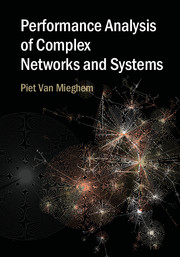Book contents
- Frontmatter
- Dedication
- Contents
- Preface
- Symbols
- 1 Introduction
- Part I Probability theory
- Part II Stochastic processes
- Part III Network science
- 15 General characteristics of graphs
- 16 The shortest pat problem
- 17 Epidemics in networks
- 18 The efficiency of multicast
- 19 The hopcount and weight to an anycast group
- Appendix A A summary of matrix theory
- Appendix B Solutions of problems
- References
- Index
16 - The shortest pat problem
from Part III - Network science
Published online by Cambridge University Press: 05 June 2014
- Frontmatter
- Dedication
- Contents
- Preface
- Symbols
- 1 Introduction
- Part I Probability theory
- Part II Stochastic processes
- Part III Network science
- 15 General characteristics of graphs
- 16 The shortest pat problem
- 17 Epidemics in networks
- 18 The efficiency of multicast
- 19 The hopcount and weight to an anycast group
- Appendix A A summary of matrix theory
- Appendix B Solutions of problems
- References
- Index
Summary
The shortest path problem asks for the computation of the path from a source to a destination node that minimizes the sum of the positive weights of its constituent links. The related shortest path tree (SPT) is the union of the shortest paths from a source node to a set of m other nodes in the graph with N nodes. If m = N — 1, the SPT connects all nodes and is termed a spanning tree. The SPT belongs to the fundamentals of graph theory and has many applications. Moreover, powerful shortest path algorithms like that of Dijkstra exist.
Routers in the Internet forward IP packets to the next hop router, which is found by routing protocols (such as OSPF and BGP). Intra-domain routing as OSPF is based on the Dijkstra shortest path algorithm, while inter-domain routing with BGP is policy-based, which implies that BGP does not minimize a length criterion. Nevertheless, end-to-end paths in the Internet are shortest paths in roughly 70% of the cases. Therefore, we consider the shortest path between two arbitrary nodes because (a) the IP address does not reflect a precise geographical location and (b) uniformly distributed world wide communication, especially, on the web seems natural since the information stored in servers can be located in places unexpected and unknown to browsing users. The Internet type of communication is different from classical telephony because (a) telephone numbers have a direct binding with a physical location and (b) the intensity of average human interaction rapidly decreases with distance.
- Type
- Chapter
- Information
- Performance Analysis of Complex Networks and Systems , pp. 397 - 442Publisher: Cambridge University PressPrint publication year: 2014



